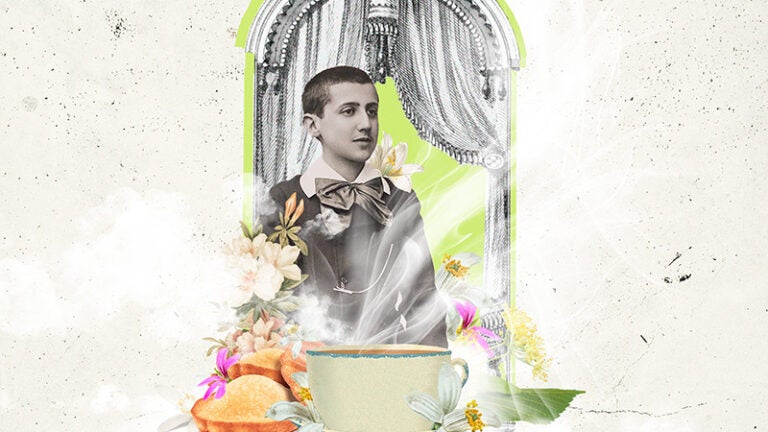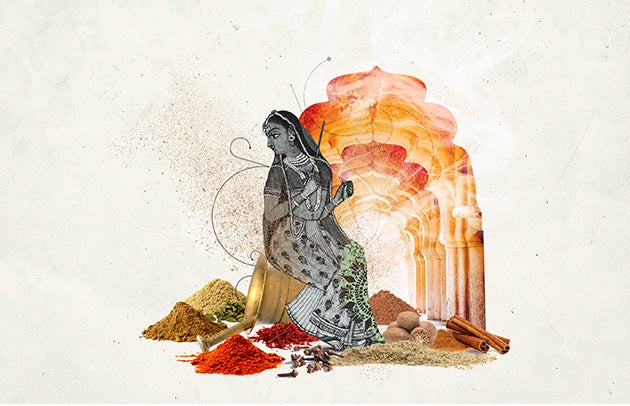
The Most Powerful Scents?
Smell is, in many ways, the most magical and mysterious of the senses. It is what allows us to perceive something that is silent, invisible, can’t be touched and is frequently so unique it cannot be bottled or duplicated. The smell of your beloved, the scent of your child, the odor of a city you visited — all are complex and tantalizingly elusive, yet instantly recognizable and familiar. But — much as we might want to — they’re impossible to preserve for posterity, the way one might photograph a loved one or record their voice.
“Researchers have tried to find the smell that reminds people of home, but there isn’t one universal smell that works for everyone,” says Norbert Schwarz, Provost Professor of Psychology and Marketing.
In Western culture, scent is strongly associated with memory, capable of generating vivid flashbacks to past events. In a famed passage from In Search of Lost Time, Marcel Proust recounts how dipping a fragrant madeleine — a small French sponge cake — into lime flower-scented tea unlocks precious childhood memories, declaring: “…when nothing subsists of an old past, after the death of people, after the destruction of things, alone, frailer but more enduring, more immaterial, more persistent, more faithful, smell and taste still remain for a long time, like souls, remembering, waiting, hoping, on the ruin of all the rest, bearing without giving way, on their almost impalpable droplet, the immense edifice of memory.”
Scent’s ability to evoke the past is not its only power. From facilitating romance and seduction to communication with the divine, our sense of smell plays an outsized role in our emotional and spiritual worlds.
The nose knows
It turns out, there’s an anatomical reason why smell seems so urgently powerful. Scent is the only primary sense that does not first get processed through the brain’s thalamus (known as the mind’s central processing unit) before being dispatched to the cerebral cortex for interpretation.
Instead, when we inhale a whiff of cedar or chocolate, this input is immediately sent not only to the olfactory and piriform cortex for interpretation but also to parts of our brain that process emotion, associative learning, memory and behavior — the amygdala-hippocampus complex. “No other sensory system has this direct and intimate connection,” says USC Dornsife’s Kurt Kwast, associate professor (teaching) of biological sciences.
The swift, involuntary reaction we have to certain scents is likely an evolutionary advantage. Stench, for instance, warns us of spoiled food, illness or death. The smell of smoke or rain, wafting toward human encampments long before the arrival of a forest fire or storm, can also be a first sign of danger.
Our aversion to the odors of rotting organic matter, that if fresh could otherwise have served as food, is so strong it transcends culture. Languages around the world possess an expression similar to the English phrases “something smells fishy” or “doesn’t pass the sniff test,” which align scents of decay with a feeling of suspicion.
Simply adding a rotten smell to a room has the power to alter human behavior, says Schwarz. “When we play economic trust games in the presence of a fishy smell, it reduces willingness to share by about 50%,” he says.
When subjects are asked questions that contain erroneous statements in a well-ventilated room, many don’t notice, he adds. “However, if it smells fishy, you are more than 20% likely to notice something is wrong,” Schwarz says.
“Anyone who was anyone in premodern India had to have a fairly sophisticated knowledge about the art of perfumery.”
Scent-imental reasons
Sweet scents, on the other hand, have been famed since antiquity for their ability to attract. In Greek mythology, the god Zeus, disguised as a white bull, seduced the princess Europa (after whom the continent is named) with an overpoweringly seductive aroma. Women in ancient Rome anointed their hair with perfumed oils and Cleopatra was said to smear her lips with such sweet-scented oils, so that her lovers would be reminded of her all day.
In the Sanskrit epic of ancient India, the Mahābhārata the fragrance of flowers is depicted as playing a central role in the founding of a dynasty.
But if smell in Western society has long been intricately linked with the evocation of memory, providing a pathway back to a former self, removed in time — although not necessarily in space — from the present, this notion was not shared by premodern Indians.
“People in medieval India thought scents please or displease, and correspondingly attract or repel. They’re not interested in the whole smell and memory thing,” says James McHugh, professor of religion. McHugh is the author of Sandalwood and Carrion, Smell in Indian Religion and Culture (Oxford University Press, 2012), which explores the olfactory sense in premodern India.
During the medieval period, India — where the sense of smell played a crucial role in daily life and religious ritual — was the hub of the aromatic world.
“Not only did the country produce many key ingredients,” McHugh says, “including sandalwood, saffron and cardamom, it was also at the crossroads of the trade in rare and exotic aromatics used to make costly perfumes, with cloves, nutmeg and camphor coming from Southeast Asia, frankincense and myrrh from the Persian Gulf and musk from the Silk Route to the north.”
During that period in India, the complex and creative use of aromatics was considered vitally important in enhancing pleasure to achieve an ideal love life, with perfumes of the period bearing deceptively avant-garde names such as Uproar, Moon Juice, Outrage and Who’s He?
Medieval Indian perfumes also provided a visual experience. Fragrances were diffused using pastes, tinted orange from saffron or white from camphor, rather than alcohol, which was not at that time used as a base for perfumes.
“Nowadays, you can’t tell if I’m wearing a scent. In medieval India, with perfume, you could see it. You would feel it on your body, everyone would see you wearing it, it was a multisensory experience,” says McHugh.
Ancient India was so taken with perfume that savoir-faire about how to mix and blend scents was akin to wine knowledge today — a sign of elite status.
“Educated people appear to have been far more interested in and articulate about smells than we are,” McHugh says. “Anyone who was anyone in premodern India had to have a fairly sophisticated knowledge about the art of perfumery.”
Medieval Indians were comfortable with the pungency of their natural environment. They also preferred high levels of aromatics, in sharp contrast with today’s Western society which, as McHugh observes, is often far more concerned with masking or removing odor than creating it.
That doesn’t mean we inhabit a scentless world, however. “Often when you wash your clothes or your dishes, you’re using perfume, although we don’t think, ‘I’m going to go put some perfume on my plates,’” says McHugh.
My chemical romance
A more intimate smell has recently emerged as a potential factor in human attraction: “pheromone-like” secreted or excreted chemicals that trigger a social response.
The possibility that love — or at least sexual attraction — might literally “be in the air,” has not only engendered an ongoing cultural and scientific debate, but has unsurprisingly been seized upon by scent manufacturers. A roll-on perfume with a “pheromone elevation” became a Tik-Tok phenomenon last summer.
The science is still unclear, however, on how dominant a role personal odor actually plays in generating attraction, particularly considering humans lack the vomeronasal organ, or Jacobson’s organ, used by other mammals, as well as amphibians and reptiles, to interpret true pheromones.
However, small-scale studies have demonstrated that olfactory cues may still influence mate selection. A study in which women were asked to sniff shirts worn by men and then select the most attractive, found that they liked men genetically dissimilar to themselves.
Another study in which men sniff-tested cotton pads that women had used to swab their armpits found the men preferred the fragrance of women who were closer to ovulation and therefore more fertile.
“The idea of scent attraction is not mythical; there’s enough to suggest an association,” says Kwast. Of course, mate selection isn’t entirely down to smell. Other studies have found that people select mates whose faces most closely resemble their own, and lived experience shows us that people are attracted to others for a whole range of reasons beyond the physical.

Holy Smokes
Scent has also long been associated with the divine. Incense is used in the worship of deities worldwide, from paganism to Buddhism to Christianity. Smoke from frankincense or sandalwood was thought to carry prayers up to heaven, a sentiment reflected in Psalm 141:2 of the Bible: “Let my prayer be set forth before thee as incense; and the lifting up of my hands as the evening sacrifice.”
A sweet-smelling church was an effective incentive to draw people to Mass by providing them with some relief from the unpleasant odors of an everyday life in which plumbing was largely nonexistent. Incense helped people envision what heaven might be like.
“For Catholicism, burning incense is partly about creating a ritual atmosphere that supports prayer and worship,” says Dorian Llywelyn, president of USC Dornsife’s Institute for Advanced Catholic Studies.
But incense and its sensual pleasures were also believed to have the power to disrupt. Early Christians denounced its use as pagan practice and, later, during the Protestant Reformation, incense was banned from churches, along with other “decadent” accessories like flowers and images.
“The Reformation thinkers were generally very distrustful of all the senses — except for hearing. Words were the big thing that counted, and they feared anything else would distract people’s religiosity and lead them into idolatry,” says Llywelyn.
Smell can also connote profound personal holiness. In 1918, Padre Pio, an Italian monk, was reported to have begun displaying the stigmata — marks resembling Jesus’ crucifixion wounds — while also emitting a strong perfume of violets.
The bodies of many Catholic saints, among them Saint Teresa of Avila, are reputed to have smelled of flowers after they died.
For Catholic believers, such stories seem to confirm that saints possess extraordinary holiness and show the truth of the Christian gospel of resurrection, which promises to restore the deceased to new life. “Such smells are almost a foretaste — a ‘glimpse through the nose’ — of what salvation would actually include,” says Llywelyn.
Parallels can be drawn with medieval India, where odors not only had the power to attract or repulse but were also considered indicators of virtue. Indeed, perfumes and aromatics, along with the sense of smell itself and other odors — both good and bad — were used as tools to create order in the universe as well as material and ethical hierarchies. Thus, for medieval Indians, the good and the godly literally smelled divine, while evil stank.
Saved by the Smell
We’re still devising new ways to use the power of scent. Alumni Marat Zanov ’09 and Dawn McDaniel ’10, who both earned PhDs in psychology, added odors to their virtual reality program, which eases symptoms of PTSD in veterans by enabling them to relive past trauma in a safe environment.
Zanov, a former U.S. Air Force captain, notes the power of smell to take us back to moments of extreme stress.
“A veteran might be mowing his lawn on a peaceful summer’s day and suddenly the smell of gasoline from the lawn mower will trigger a flashback to a terrifying roadside bomb attack he experienced while serving in Afghanistan,” he says.
Incorporating such odors in the VR program, in which participants are guided visually through distressing memories, is an effective way to help participants relive painful episodes from their past in an effort to combat PTSD. Evoking the past through smell, Zanov and McDaniel argue, could help us heal for the future.